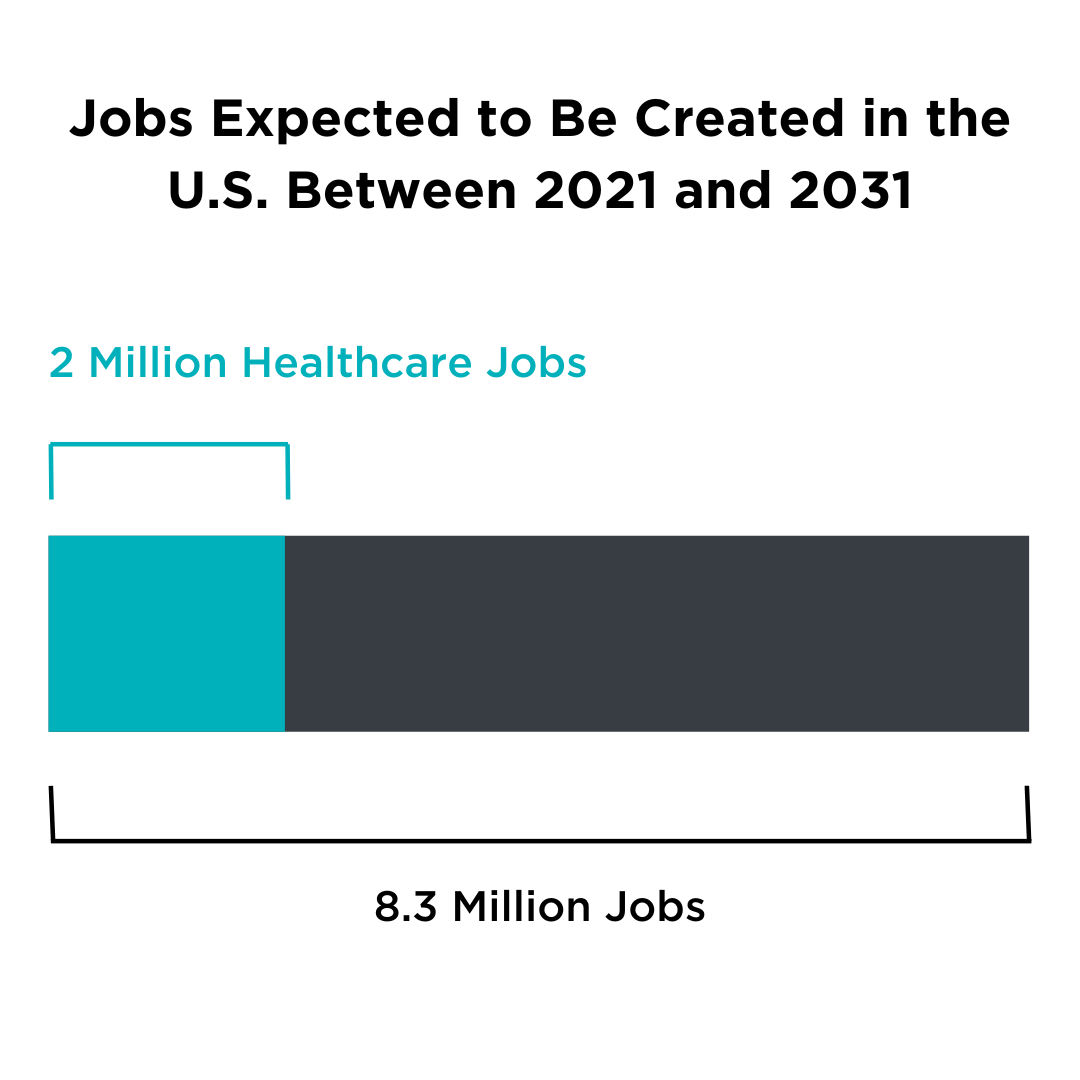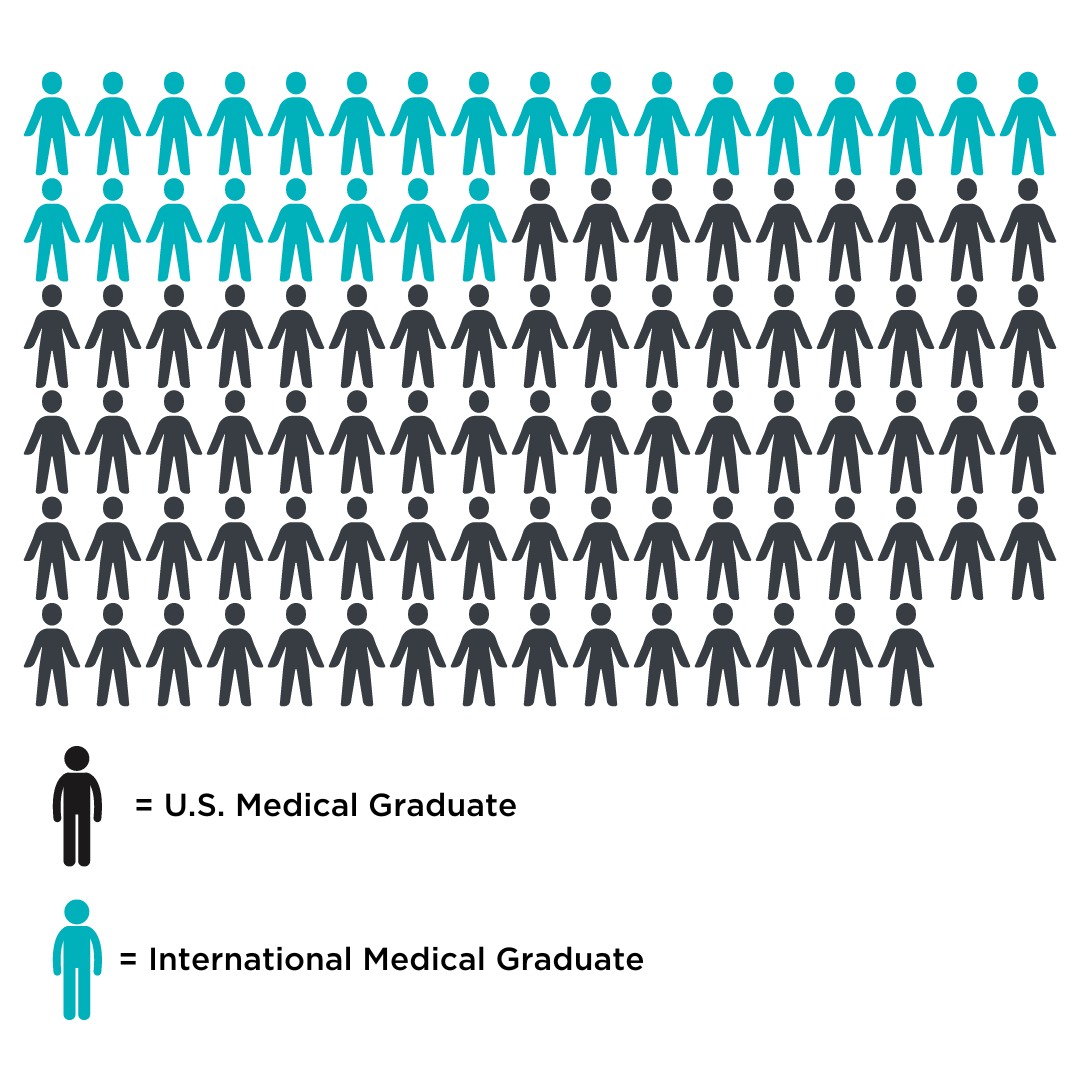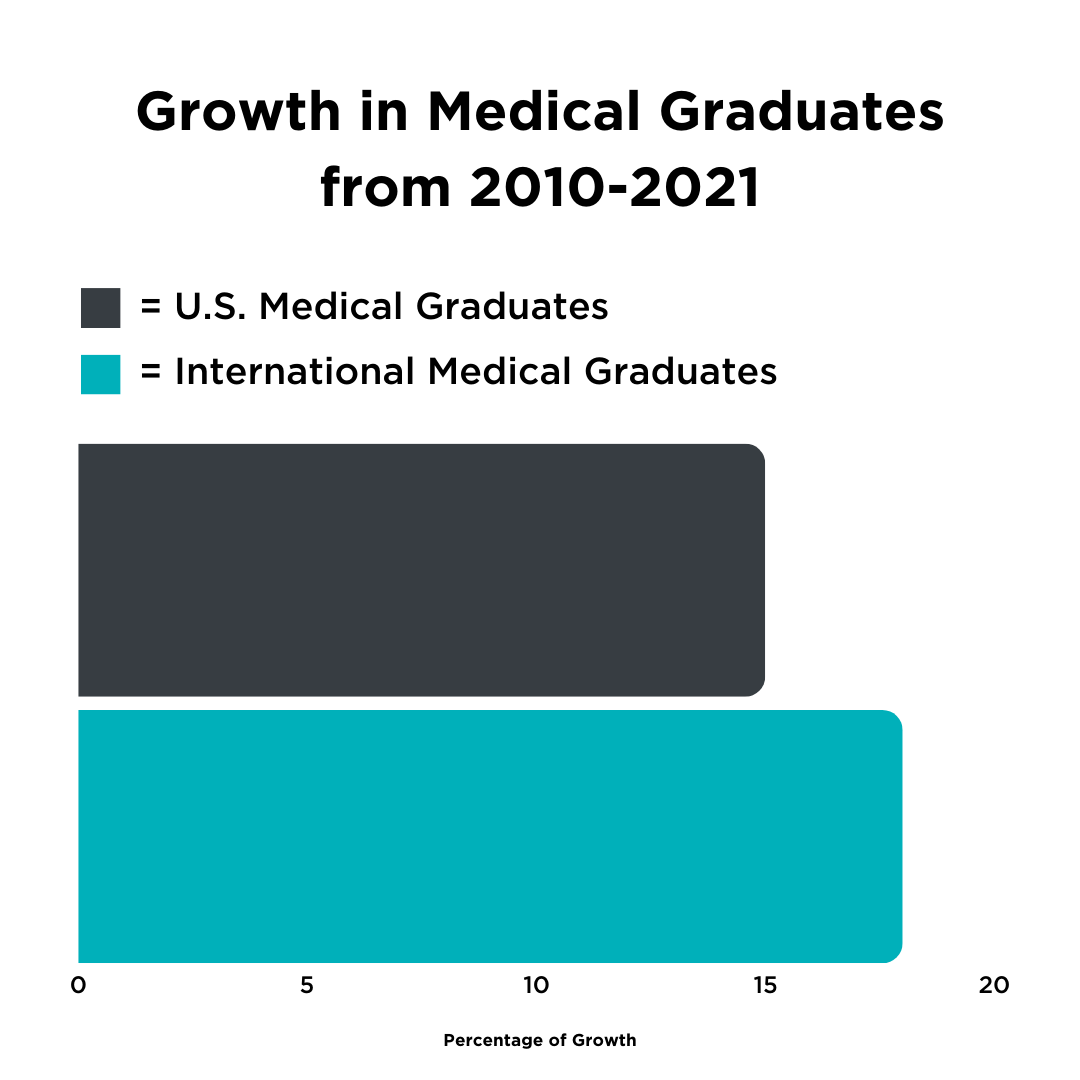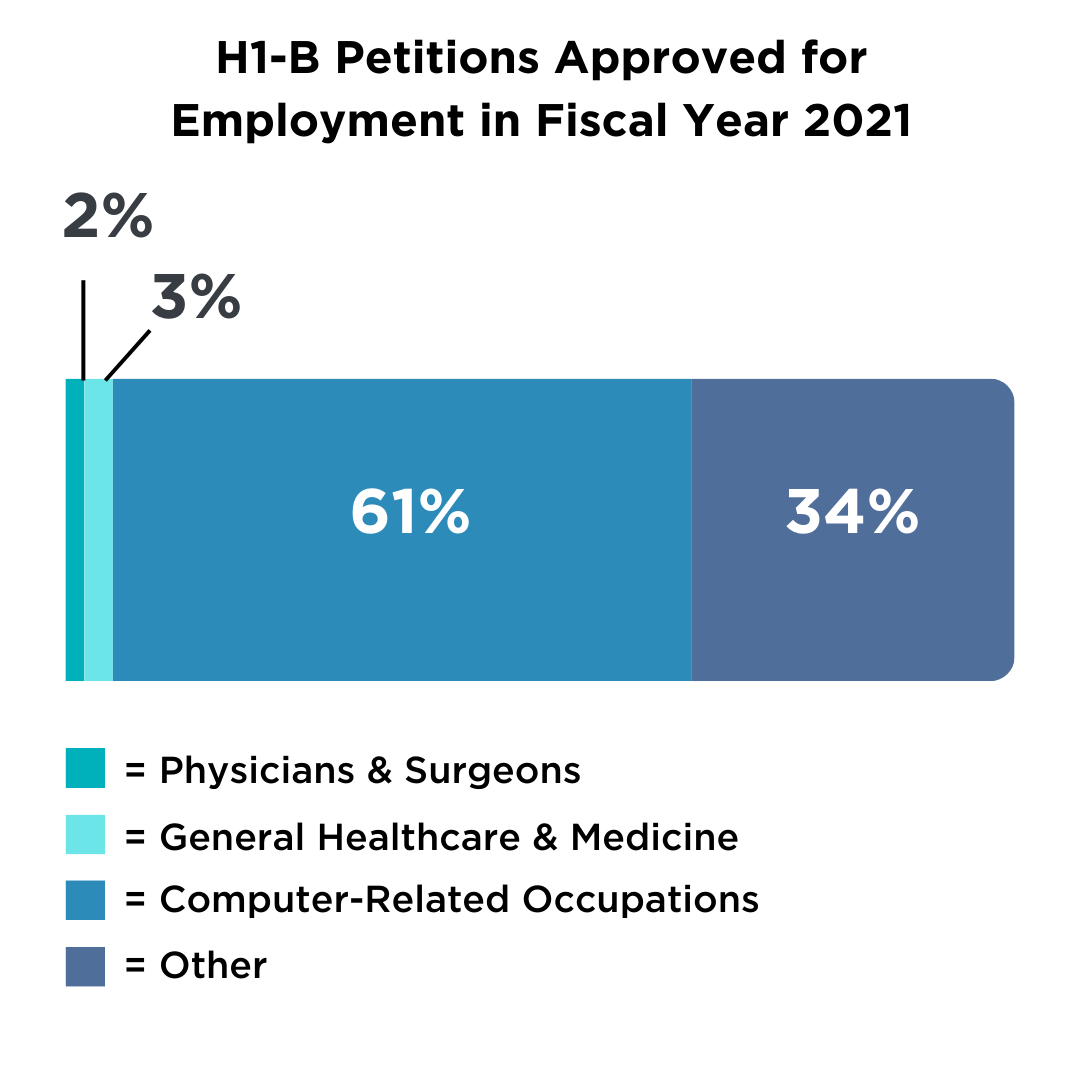The Healthcare Shortage In Cleveland
Cleveland may be renowned around the world for our exceptional healthcare providers and hospitals, but it is no secret that Ohio is experiencing a demand for physicians.
In fact, the data shows that workforce shortages in healthcare aren’t unique to Northeast Ohio; they are affecting the entirety of the U.S. Because of the absolute necessity of accessible, quality healthcare for each and every person, addressing this situation isn’t just important, it’s crucial.
*Graph created by the Association of American Medical Colleges
In Northeast Ohio, our population and workforce continues to dwindle, falling to keep pace with our region’s growing needs. The report, Aligning Opportunities in the Northeast Ohio Region, found that from 2001-2019, the region’s population dropped by 173,000 people. In that same time frame, Northeast Ohio’s labor force dropped by 156,000.
While shortages exist in a variety of our industries, including manufacturing and IT, healthcare leads the region in demand. According to Aligning Opportunities in the Northeast Ohio Region, approximately 7,842 entry-level healthcare positions went unfilled in 2019. In order to align our state’s demand for healthcare workers with our population growth, our workforce must expand 8% by 2030.
The U.S. could see a shortage of as many as 139,000 physicians by 2033
The U.S. needs an additional 23,000 surgeons by 2032
By 2025, Ohio is expected to be short 1,200 primary care physicians
7 in 10 Ohio nurses are considering leaving the profession
Ohio has a shortage of 627 dentists
The longer life expectancy for the population, as well as the trend of an aging population, will cause an even greater demand for healthcare practitioners. In fact, he Population Reference Bureau projects that from 2022-2050, the number of Americans ages 65 and older will increase by 47%, making their share of the total population rise from 17% to 23%. They also reported that, based on the median age across the country, the U.S. population is older today than it has ever been.
The projected demand for healthcare workers by the U.S. Bureau of Labor Statistics can also be explained by healthcare professionals leaving the profession due to retirement. The Migration Policy Institute reports that “18 percent of physicians, surgeons, and registered nurses are within ten years of expected retirement (meaning they were between ages 55 and 64) as of 2021.”
The U.S. Bureau of Labor Statistics estimates that between 2021 and 2023, healthcare occupations will account for 2 million of the 8.3 million jobs created in the United States.
As the need for healthcare workers continues to escalate, people are beginning to ask, “how do we fill this gap?” Data shows that new births in our country will not be enough to fill our needs. The Centers for Disease Control and Prevention reports that the birth rate in the U.S. has reached a historic low, decreasing by 3% from 2022. They report that from 2014-2022, the birth rate has consistently decreased by 2% every year.
In summary:
- Northeast Ohio is experiencing continuous population and workforce decline.
- The birthrate in the U.S. is at a historic low.
- The demand for healthcare professionals is rapidly growing.
- Medical professionals are aging and retiring at a high rate.
- The U.S. population is trending older, bringing with it an increased demand for healthcare.
This begs the question: where will we find workers to fill the demand for an aging population that is losing workforce and having less children than ever before?
The Solution to Northeast Ohio's Healthcare Worker Shortage: IMGs
Where is our solution to the healthcare shortage? It lies in International Medical Graduates (IMGs).
An IMG is an individual who completed their medical schooling outside of the United States or Canada. This categorization of healthcare professionals can include native-born Americans that received medical training outside of the country, but it most often describes individuals who were both born and educated outside of the U.S. The National Institutes of Health (NIH) reported that nearly 90% of IMGs are non-U.S. born, and over 75% of that population come from low-resource, developing nations.
IMGs already make up a significant portion of the country’s physician workforce. NIH found that IMGs make up a quarter, or 25%, of the physician workforce in America.
While IMGs make up a smaller population of the medical field when compared to U.S. Medical Graduates, they are growing at a faster rate than their native-born counterparts. The American College of Physicians reports that from 2010-2021, the number of U.S. Medical Graduates increased by 15%. During that same time, the number of IMGs in the healthcare field increased by 18%.
The American College of Physicians report the disbursement of IMGs to be 32% in the South, 28% in the Northeast, 20% in the Midwest, 17% in the west, and 3% in territories and military bases. They also report an increase in female IMGs from 25% to 45% between 1990 and 2014.
Not only are IMGs filling crucial gaps in our workforce, they also make up a significant portion of the population educating the next generation of medical workers. Out of around 80,000 academic physicians in the U.S., more than 18% are IMGs, reports the Annals of Internal Medicine.
International Medical Graduates and Visas
The United States is failing to prioritize the attraction of new IMGs, and with the aging trend of our population and the low birthrate, seeking to grow our population with International Newcomers is essential. While foreign-born workers in healthcare can enter the United States via a variety of visas, one of the most common temporary visas for an IMG to obtain is called an H-1B. The H1-B visa is designated for those who work in specialty occupations.
The Migration Policy Institute reported that out of the 123,400 H1-B petitions approved in fiscal year 2021, only 5,600 went to healthcare and medical occupations and only 2,800 went to physicians and surgeons.
IMGs are being underutilized. While we face a staffing shortage in healthcare, approximately 270,000 International Newcomers with a college degree in healthcare faced skill underutilization (working in a lower-skilled job) or unemployment, reports the Migration Policy Institute.
International Medical Graduates and Residency Requirements
Once in the U.S., many IMGs face another challenge: obtaining a medical residency.
For medical graduates seeking to become physicians, they need to complete a medical residency. In the U.S., the process of pairing a medical graduate with a residency is called The Match, or matching, short for the National Matching Program.
A study in the Journal of General Internal Medicine found that IMGs were three times as likely to be selected into community programs instead of university programs for residency, citing that departmental pressure, concerns surrounding reputation, and priority given to certain institutes were some of the reasons that IMGs were not chosen for university programs.
The National Library of Medicine published an article stating that, “[IMGs] must build a highly competitive profile aiming for a barely equal chance of matching their US peers.”
For example, data published by the National Matching Program shows how internal medicine IMGs are matched with residencies of their chosen specialty far less often than U.S. peers with the same Step 1 score.
IMGs can also face a delay in joining the healthcare field in the U.S. depending on the level of medicine they seek to practice and the licensure it requires.
State Regulations for IMGs
States are varied in their approach to IMGs. Many have taken to submitting new legislation to get IMGs working in our healthcare system faster, while still maintaining quality of care.
Washington IMG Bill
Washington state passed legislation in 2021 that gives IMGs a temporary license to practice.
Requirements include:
- Working under an already licensed doctor
- Have passed the USMLE exam
- English proficient
This license can be renewed.
Washington passed an IMG bill in 2019, and significantly expanded it in 2021. They are already seeing positive results from their IMG legislation.
Alabama IMG Bill
A Republican standalone bill for IMGs was passed in Alabama in 2023. This bill:
- Allows IMGs to apply for a temporary renewable license one year earlier during their training
- Eliminates the Special Purpose Exam (SPEX), an additional test
- Creates a program for grads who were not Matched into a residency program to train under a licensed Alabama physician

Illinois IMG Bill
In 2023, Illinois signed into legislation two bills that will help break down barriers for IMGs to practice in the U.S. As Upwardly Global reports, the legislature created an alternative, permanent pathway for IMGs to obtain full licensure. They also created an ombudsman position, that will help IMGs navigate relicensing. Illinois will be able to “issue limited licenses to international medical graduates (IMGs) who are fully licensed physicians in their country of origin. These IMGs will be able to practice in the state under the direct supervision of an Illinois licensed physician,” according to the Illinois State Medical Society.
Furthermore, the Illinois House Health Care Licenses Committee passed a bill in April 2024 creating a clinical readiness program. This will help IMGs find a residency program in Illinois, which will help IMGs get working, and also increase the likelihood that the IMG will practice in the state after their residency.

Tennessee IMG Bill
Tennessee signed into law in 2023 a bill that will allow IMGs skip residency by instead getting a 2-year provisional license at a healthcare facility with an accredited residency program.
The IMGs can bypass residency if:
- They receive an offer of employment from a residency hospital
- They have obtained certification by the Educational Commission for Foreign Medical Graduates (ECFMG)
- They pass the U.S. Medical Licensing Exam (USMLE) Step 1 and 2 CK
- They have completed a 3-year residency at an accredited international program
IMGs will then receive a full-license after two years.
The New England Journal of Medicine released an article claiming that Tennessee law “…offers a model for attracting IMGs to practice in the United States.” In Tennessee Leads the Way in Removing Barriers to Foreign Doctors on the CATO Institute, the author said that Tennessee’s bill “…breaks down barriers that prevent foreign doctors from helping address the worsening physician shortage.”

What Ohio Can Learn from IMG Legislation
The legislation being adopted in states across the country comes from both sides of the political aisle, showing that this is not a partisan issue. The states also alter the legislation to best fit their needs, whether it be getting IMGs in the workforce faster, or supplying rural, understaffed areas with much needed medical care.
To put it simply, each state that has adopted IMG legislature for easier integration into their healthcare system has seen a success that we should try to emulate. If Ohio wants to maintain our industry-leading, competitive healthcare sector, it’s important that we keep pace with other states and their adoption of IMG legislation.
Supporting Newcomer Healthcare Workers
While actively advocating for IMG legislation, Global Cleveland continues to support the pursuits additional healthcare positions for International Newcomers.
Our workforce team will make referrals to partners for healthcare careers in the following programs:
- Phlebotomy
- STNA
- Community Health Worker
- Medical Coding
- Medical Assistant
- Sterile Processing Tech
We also have strong relationships with resettlement partners who can connect International Newcomers with entry-level jobs at University Hospital and Sodexo, including:
- Nutrition Services
- Meal Delivery
- Dishwashing
- Meal Dispatching
- Facilities Management
Global Cleveland is aware of other sector workforce issues and different solutions could be advanced through partnership, including:
- Nursing (re-credentialing and exchange)
- Medical Innovation
- Healthcare Workforce Resilience Act
Supporting IMGs in Northeast Ohio
Cleveland’s strongest sector is our healthcare, and we lead in this sector because of our ability to innovate, as well as attract talent from around the world.
If you’re committed to expanding our healthcare sector and filling the gaps in our workforce, we ask that you join us in voicing support for consideration of IMGs in our legislature and sharing this article and information about IMGs with your friends and colleagues.
###
If you are an organization or International Newcomer interested in learning more, send us an email to connect with our team.











